
Gamma-ray Burst 971214

A moderate Gamma-Ray Burst (BATSE trigger No. 6533, 3500 cts/s) was detected
by basically all active GRB instruments (BATSE, GRBM/BeppoSAX, RXTE/ASM)
on December 14, 1997 at 23:20:43 UT. With the BeppoSAX WFC the location
could be reduced to a 3.9 arcmin error circle centered at
R.A. = 179.125, Decl. = +65.20 degrees (2000.0).
A TOO observation with BeppoSAX has been scheduled 6.5 hrs after the GRB.
Unfortunately, the GRB location is not reachable for ROSAT due to Sun angle
constraints. There exists no serendipituous ROSAT pointing towards the
GRB location, and during the ROSAT all-sky survey (exposure of 580 sec) no
X-ray source was detected within or near to the WFC error error circle.
(All information courtesy of the instrument teams and GCN messages.)
 Previous IAU Circulars
Previous IAU Circulars
- IAUC
6787 Location with WFC/BeppoSAX
- IAUC
6788 fading optical counterpart
- IAUC
6789 BATSE/Ulysses IPN arc and RXTE/ASM location
- IAUC
6791 further optical brightness estimates for OT
- IAUC
6792 X-ray afterglow detected with BeppoSAX NFI
- IAUC
6793 KPNO imaging: I = 22.9+/-0.4 on Dec. 17.37 to 17.55 UT
- IAUC
6794 brightness predictions for X-rays and optical wavelengths
- IAUC
6795 non-detection with EUVE
- IAUC
6796 R-J=+1.8+/-0.3 on Dec. 15.5, 1997
 Results of Observations
Results of Observations
- BeppoSAX page on
GRB 971214 gives details about the fading X-ray source. The X-ray image
below is also taken from that page showing three MECS snapshots of the
fading afterglow source 1SAXJ1156.4+6513 (R.A.=11h56m25s, Decl.=+65o13'11";
equinox 2000.0, error radius about 1 arcmin).

(This is the Picture
of the Day from May 28, 1998 ).
- Optical images
taken at MDM on Kitt Peak (see IAUC 6788).
- GCN3 message
D. A. Frail and S. R. Kulkarni report on behalf of a large
collaboration that two observations have been made of the GRB 971214
field at a frequency of 8.46 GHz. Data was taken beginning on December
15.67 and December 16.34 UT of a 5.3 arcminute field (half power
diameter) centered on the NFI position. The rms noise for each of
these fields is 50 microJy and 17 microJy, respectively, with a
synthesized beamsize of approximately 11 arcseconds. Within the revised
1 arcmin radius error circle (as reported by L. Piro on December 16)
there are no radio sources detected at a level of 3-sigma or greater.
- GCN3 message
A.A. Henden, C.B. Luginbuhl and F.J. Vrba (U.S. Naval Observatory
Flagstaff Station) report that they obtained a total of 111 min
integration of the revised SAX localization for GRB971214. The data
are a combination of 600-sec and 30-sec exposures taken with the
1.0-meter telescope using a Tek2048^2 CCD and a R-band filter. It is
hoped that the short exposures will allow the recovery of at least some
information in the region near the bright star HD103690 (V=6.7) located
within the localization. The first image began 1997 Dec 15 10:44 UT,
the last ended 13:42 UT. Images are presently being processed. There
are no obvious differences between these images and the DSS. When
completed, a stacked and trimmed composite of all images will be posted
on our anonymous FTP site (ftp.nofs.navy.mil / 192.68.148.67) for
comparison with earlier or later epoch data. To get the image, login
as "anonymous", use your email address as the password if required.
The file will be /pub/outgoing/fjv/grb971214-1214R.fts.
-
BATSE lightcurve (from M. Kippen's page)
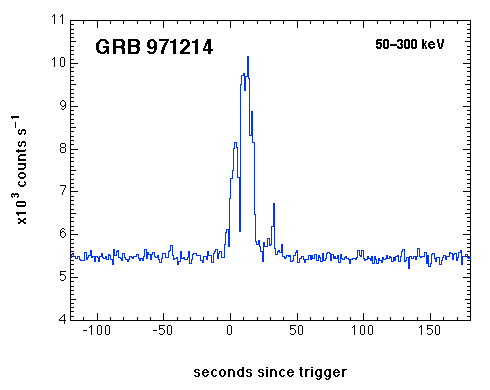
- Location map (from M. Kippen's page)
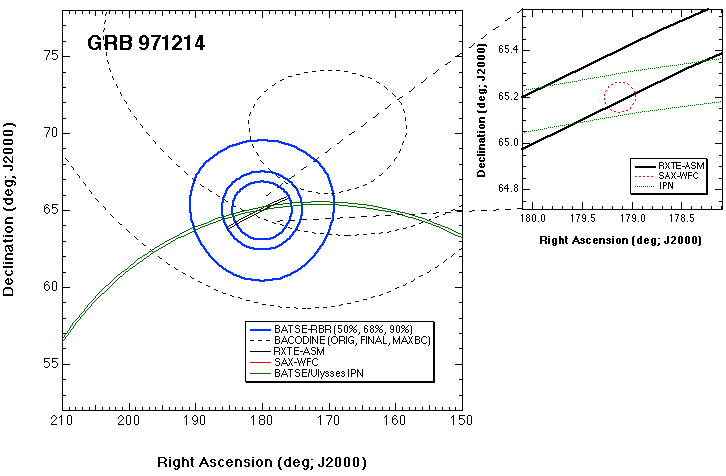
- DSS image with SAX WFC (IAUC 6787) and NFI (IAUC 6792) position,
and OT position (IAUC 6788).
The bright star in the northern part of the WFC box is HD 103690, a 7th
magnitude G5 star.
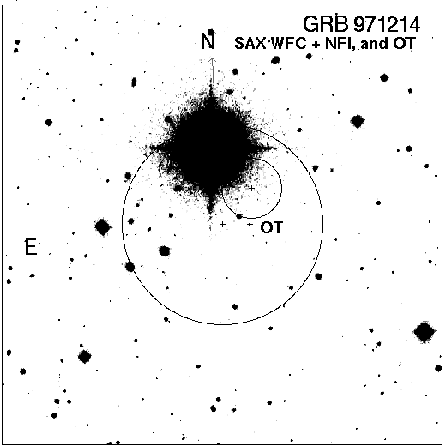
- GCN3 message
A. Diercks, E.W. Deutsch, University of Washington, R. Wyse, The Johns
Hopkins University, G. Gilmore, Cambridge University, C. Corson,
Apache Point Observatory, F. Castander, University of Chicago, and
E. Turner, Princeton University confirm the fading optical transient
reported by Halpern et al. in IAU 6788. We measure R.A. =
11h56m26.35s Decl. = +65o12'0.7" (equinox 2000.0). The object was
observed to fade by approximately 1.6 magnitudes in R-band over 24
hours in images taken by Corson, Gilmore and Wyse with the ARC 3.5-m
telescope at Apache Point.
On Dec 15.51 UT, R=22.1+-0.1 and on Dec 16.52 UT, R=23.7+-0.3.
Magnitudes were calibrated based on R_F magnitudes for bright stars in
the field from the APM survey. In this system we measure coordinates
for two reference stars. Ref1 (11h56m25.75s, +65o12'0.7") R=20.10 +-
0.01, Ref2 (11h56m34.22s, +65o11'44.2") R=20.78 +- 0.03. Estimated
zero point errors are approximately 0.3 magnitudes. No other object
brighter than approx R=21.5 was observed to vary. Our R-band
observations on Dec 15 and Dec 16 were approximately coincident with
the reported MDM I-band detections by Halpern et al, (IAUC 6788)
giving an R-I color for this object of R-I = 1 +/- 0.4. Within the
quoted measuring errors, the color is constant during the fading.
Images
are available at http://www.astro.washington.edu/deutsch/misc/grb971214/.
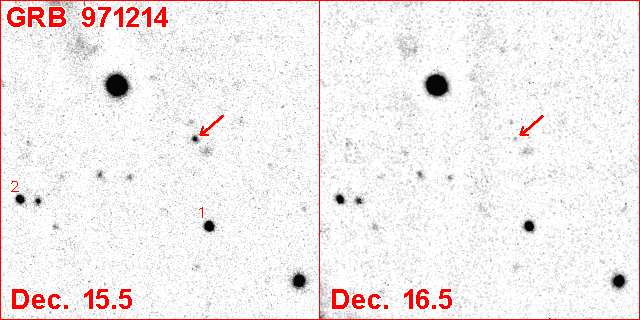
- GCN3 message
S. R. Kulkarni (CIT), J. S. Bloom (CIT), D. A. Frail (NRAO), R.
Goodrich (CARA), and A. N. Ramaprakash (CIT) report on behalf of the
Caltech GRB collaboration: "We have obtained a series R- and I-band
images of the SAX localization (IAUC 6787) of GRB 971214 using the LRIS
instrument on the Keck II 10-m telescope on the nights of Dec 16 and
Dec 17, 1997 UT. The OT reported by Halpern et al. (IAUC 6788) appears
to have faded by about 0.5 magnitude with respect to two nearby faint
stars over a 24-hour interval between UT Dec 16, 1997 and UT Dec 17,
1997. We note that Diercks et al. (GCN email) report a faster fading
rate but in the R-band. We caution our results are preliminary.
Pending a more thorough analysis of the photometry we request that
the above photometric information not be cited.
The OT is very well detected on Dec 16, 1997. The photometric precision
is 0.7%. The seeing during the first epoch I-band images was ~0.65
arcsec (FWHM) and the OT appears completely consistent with a point
source (similar to that of GRB 970508). Two extended galaxies are
found within a radius of 5-arcsecond of the OT. The seeing during the
second epoch is comparebly good."
- GCN3 message
On 17 December UT, we observed the candidate optical counterpart to GRB
971214 that was reported by Halpern, Thorstensen, Helfand, Costa, et al
(IAU Circular 6788). We used the Kitt Peak National Observatory 0.9
meter telescope with a Harris I band filter. The transient source is
seen in the clipped average of forty-four 300 second exposures, though
it is quite near the detection limit. We also detect the two nearby
faint sources that are reported by Kulkarni et al and apparent in the R
band images by Diercks et al. The brighter of the two is clearly
nonstellar in our data. The observations spanned the period UT 08:55
to 13:18 on 971217. The point spread function of the final image has
approximately a 2 pixel (approx 1.6 arcsec) full width at half maximum.
Photometry with a 2 pixel (approx 1.6 arcsec) radius aperture yields
an I magnitude difference of +4.4 +- 0.4 magnitudes between the optical
transient and to the bright star ~ 26 arcseconds SSW of the transient.
Other magnitudes relative to this same reference star are
-2.52 +- 0.015 Bright star ~ 26 arcsec NE of transient;
+0.33 +- 0.02 Bright star ~ 55 arcsec NW of transient;
+4.35 +- 0.35 Fainter nearby fuzzball, ~ 5 arcsec N of transient;
+3.48 +- 0.15 Brighter nearby galaxy, ~ 5.5 arcsec SW of transient;
+3.15 +- 0.15 same object, but comparing 3 pixel radius apertures.
We do not have absolute photometric calibration for our data.
A crude estimate suggests that the 3 sigma limiting magnitude of the data
set ought to be in the range 23 < I < 24.
The combined image will be linked to the KPNO GRB followup web page
at http://www.noao.edu/noao/grb/971214.html
James Rhoads, on behalf of the Kitt Peak National Observatory
GRB followup team.
- GCN3 message
F.J. Castander, University of Chicago, R. Wyse, The Johns
Hopkins University, G. Gilmore, Cambridge University, C. Corson,
Apache Point Observatory, A. Diercks, E.W. Deutsch, University
of Washington, D.Q. Lamb, University of Chicago, and E. Turner,
Princeton University report: ``Observations made on Dec 17 UT
using the ARC 3.5-meter telescope at Apache Point Observatory show
that the optical transient reported by Halpern et al. in IAUC 6788
has continued to fade. We measure on Dec 17.51 UT a magnitude
R=24.4+-0.5 for the OT, from six 10 min exposures taken by Corson,
Gilmore and Wyse. Calibration of photometry has been done using
Landolt standard star 104239.
- GCN3 message
S. G. Djorgovski, S. R. Kulkarni, J. S. Bloom (Caltech), R. Goodrich (WMKO),
and D. A. Frail (NRAO) report on behalf of the Caltech GRB collaboration:
Analysis of the spectra of the proposed optical transient counterpart (OT)
of GRB 971214, obtained at the Keck-II 10-m telescope on 17 Dec 1997 UT,
shows a possible detection of an extended emission line at a wavelength of
7567 A. It is also intriguing that a faint emission line at a similar
wavelength (7533 A) has been detected from a faint galaxy about 4.5 arcsec
north of the OT (see our previous email on GCN3). If this line emission from
the OT is real, it can be interpreted as the [O II] 3727 line at z = 1.03.
However, we emphasize that this marginal detection has to be checked with
additional data.
- GCN3 message 19 Dec 1997
M. Boer (Centre d'Etude Spatiale des Rayonnements / CNRS Toulouse), B.A.
Roberts, R. Malina (Center for EUVE Astrophysics, Berkeley), M. Feroci,
L. Piro (Istituto di Astrofisica Spaziale / CNR Roma), K. Hurley (Space
Sciences Laboratory, University of Berkeley), communicates: EUVE observed
the position of the X-ray counterpart of GRB 971214 between December
15.8, and December 16.16 UT. No source was detected during the 2000
second observation made with the Lexan (100 A) filter. The 3 sigma upper
limit to the count rate us 0.002 c/s. Assuming an hydrogen column density
of 10^20 cm^2 this converts to an upper limit to the flux of about 1.7 x
10^-13 erg/cm^2/s.
- GCN3 message #015 (24 Dec 1997)
I. A. Smith and R. P. J. Tilanus report on behalf of the James Clerk
Maxwell Telescope (JCMT) GRB collaboration:
We used the SCUBA sub-millimeter continuum bolometer array on the JCMT
to observe GRB 971214 on several occasions. We mapped the error box of
1SAX J1156.4+6513 (IAUC 6792) on UT 1997 Dec 16. No sources were detected
at 850 microns, with a preliminary rms of 3 mJy in the central region of
the map. The optical transient (IAUC 6788) was near the edge of this map,
where the rms is approximately 5 mJy. Follow up photometric observations
of the optical transient did not detect a source at 850 microns, with
rms 1.4 mJy on UT 1997 Dec 17, 1.9 mJy on Dec 19, and 1.3 mJy on Dec 22.
Combining all the photometric observations gives an rms of 1.0 mJy.
- GCN3 message #016 (24 Dec 1997)
A.A. Henden, C.B. Luginbuhl and F.J. Vrba, U.S. Naval Observatory
Flagstaff Station, report a single measure of the OT reported by Halpern
et al. (IAUC 6788), obtained from a composite R-Band image with 80min
total exposure spread over Dec 15.4535-15.5593 UT (midpoint Dec 15.5064) as
R=21.67 +/- 0.10. This is in effect a differential magnitude with
respect to stars 1,5-9 listed in the table below. We caution that this
measure is approximate since we as yet have no calibrated color
information for the OT to permit accurate transformation to the
standard system; the error of +/- 0.10 mag includes only the photon
statistical contribution and does not include any error introduced by
the lack of the color correction. We would like to here acknowledge
the assistance of Jan van Paradijs at UAH/University of Amsterdam and
J. Heise at SRON Utrecht, whose prompt dissemination of the SAX-WFC
position allowed us to make this early observation.
Local Standards in the GRB971214 Field:
We have further obtained calibrated BVR photometry for several objects
near the OT position, and offer them as local "standards" for
calibrating measures of the OT. The "standards" are listed here with
RA and DEC positions based on the GSC; we omit the RA hours (all 11)
and Declination degrees (all +65).
Obj RA (2000) DEC B err V err R err I err
1 56 29.896 12 16.29 17.651 0.024 16.835 0.011 16.370 0.009
2 56 25.832 11 36.29 20.1 0.1
3 56 20.239 12 34.64
4 56 13.434 11 16.00
5 56 15.102 9 47.35 19.378 0.079 18.039 0.022 17.175 0.009
6 56 6.309 10 5.77 15.412 0.018 14.816 0.090 14.445 0.008
7 56 22.332 8 26.01 18.261 0.027 17.249 0.009
8 56 33.250 9 17.90 16.449 0.019 15.861 0.009 15.471 0.021
9 55 52.290 10 15.61 19.964 0.120 18.919 0.019
NOTES: The object referred to as Ref1 by Dierks et al. (GCN Message 17
Dec 1997 and IAUC 6791) is our #2; our measure of R~20.1 is an
independent measure from the APM measure and is approximate because of
a poor measure at V and therefore uncertain color correction, but
nonetheless verifies their measure. We caution that their object Ref2
is slightly non-stellar in our images and should probably be avoided as
a local calibration source. Castander et al. (IAUC 6791) report
R=20.14 +/- 0.02 for our #2. The source located approximately 26" SSW
as noted by Rhodes et al. (GCN Message 17 Dec 1997 and IAUC 6793) is
also our #2; their object 26" NE of the OT is our #1 (they report
I=15.93 and 18.46 for #1 and #2, respectively); their object 55" NW is
our #3.
We plan to obtain further calibrated VR and I measures in this field,
weather permitting, in the coming months. A finding chart showing
these local "standards" is posted on our ftp site at
ftp.nofs.navy.mil (192.68.148.67)
as file /pub/outgoing/fjv/grb971214/locstds.ps.gz. We will update the
photometric measures as we obtain and reduce more data, and will keep
the latest data in the file /pub/outgoing/fjv/grb971214/locstds.dat. We
encourage observers to consult this file to put their measures on a
standard system.
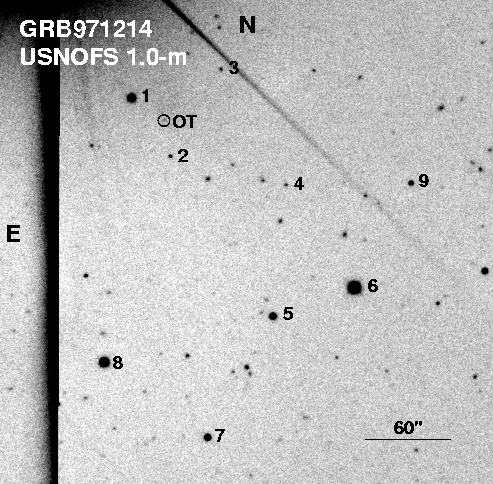
- GCN3 message #027 (Jan. 12, 1998)
S. R. Kulkarni, A. N. Ramaprakash, J. Bloom, S. Djorgovski, Caltech;
R. Goodrich, Keck Observatory/CARA and D. Frail, VLA/NRAO
report on behalf of the Caltech GRB effort:
"The optical transient (IAUC 6788) of GRB 971214 (IAUC 6787; IAUC 6792)
was observed by J. Aycock using the LRIS instrument on Keck II. The
observations were conducted between 1400--1600 UT of January 10, 1998
and images were obtained in the R band. The seeing was consistently
0.86 arcsec and 12 frames each of five minute duration were obtained.
A source is clearly detected at the position of the OT. This source is
fainter by 5.5 +/- 0.17 mag compared to object 2 of Henden et al. (GCN
note [#016] of Dec 24, 1997). We measured pixel offsets between this source
and object 2 and compared to similar offsets in the LRIS I-band image
of Dec 15.47 1997 UT (see GCN note of Dec 17, 1997). The offsets
match to better than 0.15 arcsec in each axis.
A power law fit to the I-band data of Halpern et al. (IAUC 6788) and
our LRIS I-band data of Dec 16.52 and Dec 17.45 UT predict an I-band
magnitude between 26.2 and 27.0 on January 10, 1998. The uncertainty
represents maximum errors in the extrapolation. Diercks et al. (IAUC
6791) note that the OT had R-I=1.0+/-0.4 on Dec 15.5 1997 UT. The
subsequent two R band measurements (IAUC 6791) appear to track the
I-band points (to within errors). Thus, if there is no color evolution
in the OT then the predicted R band magnitude on 10 January 1998 UT is
between 27.2 and 28.0 mag with an offset uncertainty of 0.4 mag. We
conclude that either the OT has stopped its power law decay or more
likely the host of the OT has an R magnitude of 25.6 mag."
This is citable information.
- GCN3 message #029 (Jan. 23, 1998)
GRB 971214 Optical Observations:
S. R. Kulkarni, K. L. Adelberger, J. S. Bloom, T. Kundic, L. Lubin,
California Institute of Technology, report:
"On December 28, 1997, Kundic and Lubin obtained spectra of the optical
transient of GRB 971214 (IAUC 6788) with the Low Resolution Imaging
Spectrograph (LRIS) mounted on the Keck II telescope. The seeing
conditions were excellent. If the transient continued the power-law
decay as indicated by the data from Halpern et al. IAUC 6788) then by
this epoch the light at this position should be dominated by the host
(cf. Kulkarni et al. GCN #27; ATEL #5). Analysis of these spectra show
a slightly extended emission feature at 5384 A. Additionally, a broad
absorption feature is seen at 5752 A. We cannot at this time make a
definitive statement about the redshift of the host. If, the emission
feature is identified as Lyman-alpha and the absorption feature as OI
1302 A then the redshift of the (presumed) host is z=3.43. However,
there appears to be no obvious depression bluewards of this feature as
is normally seen in high-redshift objects (caused by the Lyman
forest). If, however, the emission feature is identified with the
[OII] 3727 line then the redshift is z=0.44.
A strong emission feature at a wavelength of 5602 A is also seen in the
spectrum of the nearby galaxy G1 (GCN #12; GCN #13). Identifying this as
the [OII] 3727 A feature as well as matching major absorption features
yields a redshift of z=0.50.
We are in the process of analyzing additional LRIS data to improve the
signal-to-noise ratio and also to understand the apparent discrepancy
with similar data obtained on 17 Dec 1997 UT (GCN #12). We note that
the earlier data were obtained under bright lunar conditions while the
data reported herein was obtained during dark time.
- R-band lightcurve of GRB 971214 compared with 970228 and 970508
(from Diercks etal.,
astro-ph/9803305)

- GCN notice #098
The U. S. Naval Observatory GRB team (A. A. Henden, C. B. Luginbuhl,
F. J. Vrba, B. Canzian, S. E. Levine, H. H. Guetter, J. A. Munn)
report follow up optical photometry of the secondary standards
(see Henden, et. A. GCN 16) in the field of GRB971214. The
observations were made on four photometric nights since the burst
with the USNO 1.0m telescope. Johnson-Cousins BVRI filters were
used, with an average of 50 Landolt standards of wide color range
and extinction observed on each night. The transformations are
accurate to 0.01-0.02mag per single observation. DAOPHOT psf fitting
was used in the GRB field, with magnitude corrections to adjust the
photometry to a standard aperture diameter. Given below is the
photometry, with errors based on the variance between the four nights.
More detail, including coordinates and comparisons between other
published values for these stars, can be found next week
on our Web site at:
http://psyche.usno.navy.mil/nofs/grb/grb971214.html
For further information contact A. A. Henden at aah@nofs.navy.mil
or by telephone at (520) 779-5132.
ID B err V err R err I err
------------------------------------------------------------
1 17.676 0.026 16.849 0.022 16.378 0.006 15.971 0.011
2 22.636 0.177 21.142 0.029 20.123 0.061 18.629 0.105
3 23.337 0.329 21.641 0.221 20.462 0.055 18.959 0.053
4 23.019 0.287 21.501 0.152 20.573 0.041 19.321 0.053
5 19.418 0.031 18.069 0.039 17.194 0.016 16.382 0.041
6 15.423 0.018 14.790 0.037 14.431 0.025 14.117 0.069
7 19.934 0.081 18.298 0.036 17.270 0.014 15.971 0.011
8 16.490 0.031 15.871 0.025 15.478 0.032 15.139 0.031
9 21.341 0.056 19.913 0.035 18.970 0.040 17.991 0.053
- GCN notice #150
David W. Hogg (Institute for Advanced Study) and Edwin L. Turner
(Princeton University Observatory) report:
The very nearby (~15 pc) Galactic star SAO 15663, with V=6.7 mag, lies
2.8 arcmin from the position of the optical transient associated with
GRB971214 (not 1 arcmin as stated in Kulkarni et al, 1998, Nature 393
35; see the SIMBAD database). There are 1.0x10^{4} stars, all-sky, as
bright as V=6.7 mag (Allen 1973, Astrophysical Quantities); the
probability that the optical transient lies this close to one of them,
by chance, is 1.7x10^{-3}. This is comparable to the probability
that, by chance, the optical transient lies along the line of sight to
the galaxy (at z=3.42) identified as the GRB971214 host, according to
Kulkarni et al (ibid).
- GCN notice #702
J. S. Bloom and S. R. Kulkarni report on behalf of the larger
Caltech-NRAO-CARA GRB Collaboration:
"The Hubble Space Telescope (HST) has recently observed the hosts of GRB
971214 and GRB 980703 with STIS as part of the Survey of the Host Galaxies
of Gamma-Ray Bursts (see S. Holland, B. Thomsen, H. Hjorth et al. GCN
#698). Here we present our data reduction of this public data and relate
the new STIS images to our previously obtained ground-based data and
space-based data.
GRB 980703:
This remains one of the brightest GRB host galaxies at R~22.8 and the
inferred GRB energy release is at the high end of the GRBs energy
distribution. The optical astrometry tie from Bloom et al. (1998,
ApJL 508, 21) revealed the GRB to be nearly coincident with its host
galaxy.
The GRB host was observed for a total of 5264 s with the STIS long-pass
filter (central wavelength ~ 7230 Ang and FWHM 2720 Ang) beginning 12.42
June 2000 UT. The galaxy is compact (though resolved) and has a low
ellipticity (~12%). The effective seeing of the drizzled image is 85
milliarcsec (FWHM) as measured from a bright star in the image and the
host has a FWHM diameter of 250 milliarcsec. This is consistent with our
report in Bloom et al. of an unresolved source in 0.5 arcsec seeing on
July 18 (when the host was thought to dominate the total light of the
source). At a redshift of z=0.966 (Djorgovski et al. ApJL 508, 17, 1998),
this implies a half-light radius of ~1.1 kpc (assuming H_0 = 65 km/s/Mpc,
Omega_0 = 0.3, Omega_lam = 0.7).
For photometric zero-pointing of the HST image, we compared two compact
objects in common to our deep Keck images from 18 July 1998 in V, R, I.
We find the host galaxy has R = 22.8 +/- 0.3 and I = 22.6 +/- 0.3. The
error is dominated by the uncertainty in the color correction. These
magnitudes are both within 1-sigma of those predicted for the host galaxy
in Bloom et al. from the light curve data. We conclude therefore there is
no evidence for the presence of a second light source (e.g. a supernova
component) in the early time light curve.
GRB 971214:
At z=3.418, this burst and its host remains the furthest of GRBs with
spectroscopically confirmed redshifts and also had an implied energy
release at the high end of the GRB energy distribution (Kulkarni et al.
1998, Nature, 393, 35). Using STIS imaging from 13 April 1998 we
previously reported (Odewahn et al. 1998 ApJL, 509, 5) the host as compact
core with an irregular envelope (half-light radius of 1.3 kpc).
Morphologically and in all other observed physical properties the host is
rather typical Lyman break galaxy at comparable redshifts. Further, we
found a small but significant offset of the GRB from the nucleus of the
galaxy.
The GRB host was observed for 8599s using STIS clear mode beginning 12.21
Jun 2000 UT. The final image has achieved approximately the same depth as
our previous STIS clear imaging. A visual comparison of the two epochs
reveals no obvious new or fading component. Our conclusions about the
nature of the host and its relation to the GRB remain unchanged from
Odewahn et al.
Our final reduced images can be obtained in .fits format at
http://astro.caltech.edu/~jsb/GRB/Host/
Back to JG's
homepage
Jochen Greiner, last update: 21-Jun-2000
[Disclaimer]
![]() Previous IAU Circulars
Previous IAU Circulars 



